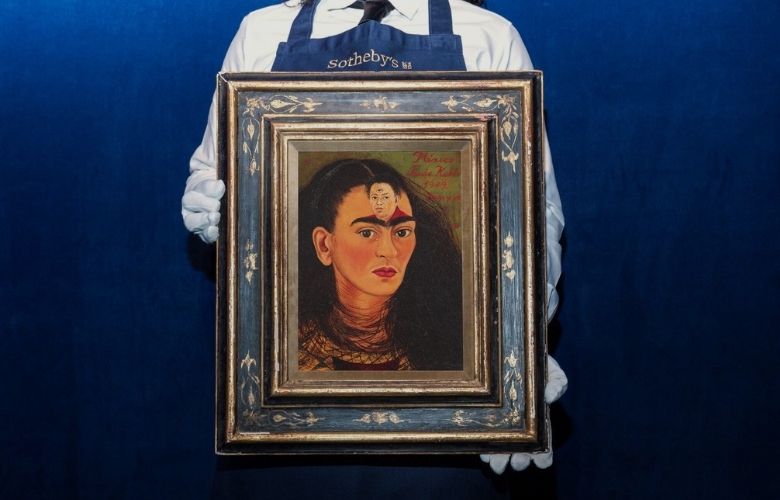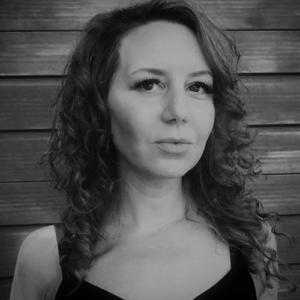
Mexican artist Frida Kahlo has broken the current world record for the highest auction price for a Latin American artwork, with her piece, Diego y Yo selling for $34.9 million at Sotheby’s in New York.
The self portrait of Kahlo shows a headshot of the artist’s signature self-portrait style, as she weeps, with her husband, the muralist Diego Rivera depicted on her forehead. Interestingly, Rivera had held the title previously for a piece that sold in 2018 priced at $9.76 million.
Sotheby’s have described Diego y Yo as “one of the most important works by Kahlo ever to come to auction.” According to the New York Times, the buyer has been named as Argentinian museum founder Eduardo F. Cosantini, who has reportedly bought the piece for his private collection, although he does plan to exhibit the painting at the Latin American Art Museum of Buenos Aires, known as MALBA, next year.
Frida Kahlo is now considered to be one of the most notable women and Latin American artists in recent history, however her life and career were marred by pain, illness, outdated attitudes to women, and a tumultuous marriage and personal life. A fascinating creative, we take a look at what led to her being a multi-million dollar selling artist in the 21st Century.

Frida Kahlo was born on 6th July 1907 in Coyocoan, Mexico City, Mexico to a German father and Amerindian and Spanish mother. Frida suffered from poor health at an early age, contracting polio at age six, which badly affected her right leg and foot throughout her life, although she battled on by partaking in sport and exercise as a girl.
While at school, Frida became interested in politics and joined a group with her peers who were similarly outspoken. She soon became fond of the group’s leader Alejandro Gomez Arias, however tragedy struck the youngsters when a bus they were travelling on together crashed with a streetcar in September 1922. Kahlo was horribly injured in the accident, with her hip, spine and pelvis suffering life-changing damage which saw her hospitalised for weeks and left in pain and with complications for the rest of her life.
As Kahlo recovered from the accident at home, she began painting while on bed rest. Encouraged by her parents who provided her with a special easel and art supplies, she created the first of her self-portraits and sought some feedback on her work. Kahlo requested that the artist Diego Rivera evaluate her work, and he encouraged her. It is said that when Kahlo was at school, she had observed Rivera working on a mural on her campus and had said to a friend that she would marry him someday.
Indeed, Rivera and Kahlo began a relationship in 1928 and married the following year. The couple soon relocated to the USA and moved around the country numerous times in order to follow Diego’s art commissions. Unfortunately, this came to an abrupt halt when Diego overstepped politically while working on a mural for Nelson Rockefeller in 1933. Rivera had tried to include Russian communist leader Vladimir Lenin in the piece he was creating at Rockefeller Center, which had been titled ‘Man at the Crossroads’. Rockefeller sacked Rivera and painted over Lenin, and both Kahlo and Rivera relocated to San Angel, Mexico after this incident.
The marriage between Kahlo and Rivera was strewn with partings and reunions, and it is well-documented that Rivera indulged in many affairs, one dalliance even with Frida’s sister Cristina. Frida was bereft, and with the addition of several miscarriages she suffered as a result of her poor health from the accident, this was an unhappy period in her life. The couple famously befriended Leon and Natalia Trotsky when they had been exiled from Russia, and Frida is said to have had a brief affair with Leon. Living separately and romantic involvements with others was a recurring theme with Frida and Diego throughout their partnership.
In this time, Frida Kahlo continued to create, and eventually considered herself a Surrealist after befriending André Breton in 1938, who is considered to be one of the primary figures of the Surrealism movement. She wrote:
“Really, I do not know whether my paintings are surrealist or not, but I do know that they are the frankest expression of myself. Since my subjects have always been my sensations, my states of mind and the profound reactions that life has been producing in me, I have frequently objectified all this in figures of myself, which were the most sincere and real thing that I could do in order to express what I felt inside and outside of myself.”
Kahlo’s art career accelerated and went from strength to strength. Later that year she exhibited at New York City Gallery, selling works and landing commissions. One controversial commission was from Clare Boothe Luce who requested Kahlo paint a remembrance portrait of her friend Dorothy Hale, who had committed suicide. It’s rumoured that Luce was physically horrified by the painting Kahlo created, The Suicide of Dorothy Hale, and had to be persuaded not to destroy it.

In 1939, Kahlo travelled to Paris where she exhibited and networked with other notable artists of the period. At this time, Kahlo and Rivera had divorced, inspiring her much-loved painting The Two Fridas.

“This portrait shows Frida’s two different personalities. One is the traditional Frida in Tehuana costume, with a broken heart, sitting next to an independent, modern dressed Frida. In Frida’s diary, she wrote about this painting and said it is originated from her memory of an imaginary childhood friend. Later she admitted it expressed her desperation and loneliness with the separation from Diego.
In the painting, the two Fridas are holding hands. They both have visible hearts, and the heart of the traditional Frida is cut and torn open. The main artery, which comes from the torn heart down to the right hand of the traditional Frida, is cut off by the surgical pincers held in the lap of the traditional Frida. The blood keeps dripping on her white dress and she is in danger of bleeding to death. The stormy sky filled with agitated clouds may reflect Frida’s inner turmoil.”
At the start of the new decade into the 1940s, Kahlo and Rivera remarried, but kept their separate lives, houses and infidelities. Kahlo’s health continued to pose a problem for her, although despite this her artwork following was growing, and in 1944 she had created one of her most famous portraits, The Broken Column.

“Pain and suffering is a constant topic in Frida’s painting. In The Broken Column, Frida expressed her anguish and suffering in the most straightforward and horrifying way. The nails are stuck into her face and whole body. A split in her torso looks like an earthquake fissure. In the background is the earth with dark ravines. In the beginning she paints herself nude but later covered her lower part up with something the looks like a hospital sheet. A broken column is put in place of her spine. The column appears to be on the verge of collapsing into rubble. Penetrating from loins to chin, the column looks phallic, and the sexual connotation is all the more obvious because of the beauty of Frida’s breasts and torso.
In the painting Frida looks pretty and strong. Although her whole body is supported by the corset, she is conveying a message of spiritual triumph. She has tears on her face, but she looks straight ahead and is challenging both herself and her audience to face her situation.”
Frida’s health had been worsening, and she underwent several more surgeries and had to wear corsets to protect her spine during this time, and in 1950 she became bedridden for nine months. Amazingly, Kahlo continued to work, exhibiting a solo show in 1953 and even attending the opening ceremony by setting up a bed in the gallery. She was the picture of tenacity and determination despite her situation, dedicated to her art beyond comprehension.
Amazingly, even after having part of her right leg amputated a short time later didn’t stop Kahlo’s creativity and political activism – she attended the demonstration against US-backed overthrow of President Jacobo Arbenz of Guatemala on 2nd July, which would ultimately be her last public appearance. One week after her 47thbirthday on 13th July 1954, Frida Kahlo passed away at her beloved Blue House.
Frida Kahlo’s fame has been steadily growing after her death, as shown by the sale of Diego y Yo. Her Blue House was opened as a museum in 1958, and by the 1970s the interest in her work and life was renewed due to the feminist movement, since she was viewed as an icon of female creativity. In 1983, Hayden Herrera published his book on her, A Biography of Frida Kahlo, which drew more attention from the public to this great artist. In 2002, a movie named Frida was released, staring Salma Hayek as Frida Kahlo and Alfred Molina as Diego Rivera. The movie was nominated for six Academy Awards and won for Best Makeup and Original Score.
Accessibility At The Smith Center Series: Part One
James “Fitz” FitzSimmons Interview: The Boys In The Band On Netflix


Michelle is a musician and composer from the UK. She has performed across the UK and Europe and is passionate about arts education and opportunities for women and girls.
Read Full Profile© 2021 TheatreArtLife. All rights reserved.

Thank you so much for reading, but you have now reached your free article limit for this month.
Our contributors are currently writing more articles for you to enjoy.
To keep reading, all you have to do is become a subscriber and then you can read unlimited articles anytime.
Your investment will help us continue to ignite connections across the globe in live entertainment and build this community for industry professionals.